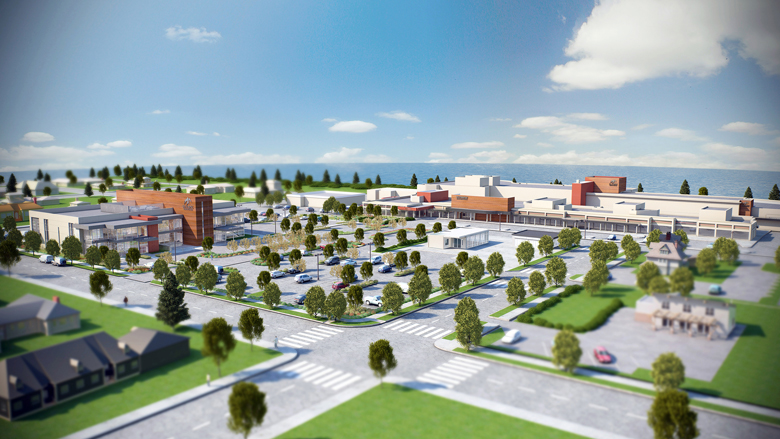PORT ANGELES — Demolition will start in a little more than a week on structures that must make way for Olympic Medical Center’s new $15.6 million office building.
Fencing already has started to surround the site across Caroline Street from the main hospital building.
Dr. Scott Kennedy, OMC’s chief medical officer, told OMC commissioners Wednesday that demolition will begin late next week, pending approval of an air-quality permit from the Olympic Regional Clean Air Authority.
The city has issued a building permit for the project.
Targeted for wrecking are several structures in the block bounded by Caroline, Race, Georgiana and Washington streets, including the former Volunteers in Medicine of the Olympics clinic, Olympic Home Health offices and hospital administration buildings.
Peninsula Children’s Clinic, 902 Caroline St., and the OMC Specialty Clinic, 923 Georgiana St., will remain until their operations move into the new two-story, 42,687-square-foot office structure.
A groundbreaking ceremony is scheduled for Sept. 22. Construction is expected to last 13 months.
“What we’re creating is a campus,” Kennedy said.
“It’s not just the block across the street but the uniting of that block with the main hospital.”
Pedestrian access
Plans for the campus include pedestrian paths across Caroline Street, which will be vacated when the medical office building opens. It will house facilities for primary care, urgent care, imaging and labs.
OMC’s construction contract with Kirtley-Cole Associates LLC of Everett totals $15.6 million. Options to the base bid could bring the cost to $16.2 million.
Olympic Electric of Port Angeles holds the electrical subcontract.
Meanwhile, new quarters for Olympic Home Health have been completed in a suite of offices at 801 E. Front St., former home of a Papa Murphy’s Take ‘N’ Bake pizza outlet.
A ribbon-cutting is scheduled for noon Sept. 2 on OMC’s expanded Emergency Department on the main hospital campus, where a new exit lane has been completed.
The larger department will feature 20 rooms, including space for patients in mental crisis, and a negative-air-pressure room to minimize the spread of communicable diseases, Kennedy said.
A floor for 2015
In other projects at OMC, a non-slip surface has been installed on the hospital’s second floor.
“For a 1950s hospital, it really brings things up to a 2015 level,” Kennedy said of the easy-to-clean flooring that also minimizes noise from carts and gurneys.
The east and south sides of the hospital also recently received face-lifting paint, and curbing at the east entrance to the hospital has been rebuilt to eliminate hazards from falls, he said.
In other action Wednesday, OMC commissioners learned that representatives of Sen. Patty Murray, D-Seattle, had visited the hospital Tuesday and that a legislative assistant to Sen. Maria Cantwell, D-Mountlake Terrace, will visit soon.
OMC officials’ message to the federal representatives is to refrain from imposing so-called “site-neutral” payment plans on the hospital. Such plans would pay OMC at the same rate as private clinics.
“Our mission is so different from a private clinic,” Kennedy told commissioners.
“Olympic Medical Center is a safety-net medical center. It’s providing something very different from what private clinics can do,” including a 24-hour emergency department.
Healthy finances
As for OMC’s fiscal condition, Julie Rukstad, chief financial officer, said the second quarter of 2015 had produced “the highest operating revenue I’ve seen since I’ve been here.”
Rukstad joined OMC in mid-2007.
Her report included net revenue of $4.9 million. Operating income also climbed, and bad debt/charity write-offs dropped 30 percent.
Operating margin stood at 7.6 percent. It was OMC’s fourth straight positive financial quarter, Rukstad said.
She credited higher volumes of patients at Olympic Medical Physicians clinics and the Sequim Cancer Center, coupled with enhanced Medicare and Medicaid payments, for the positive picture.
Visits increase
Patient visits to the physicians clinics grew 21 percent over the same quarter in 2014, and cancer treatments climbed 39 percent, although admissions to the main hospital and patient days had dropped 4 percent.
She noted, though, that patients paying for their own treatment had shrunk to 0.9 percent from the 5 percent it had been when she joined the medical center.
However, Kennedy said OMC had qualified for the federal Department of Health and Human Services 340B reduced-price drug program.
“We hope to start as early as October to get deep discounts for drugs in the outpatient clinics,” he said.
“We may be able to save perhaps up to $1 million a year.”
_______
Reporter James Casey can be reached at 360-452-2345, ext. 5074, or at jcasey@peninsuladailynews.com.

